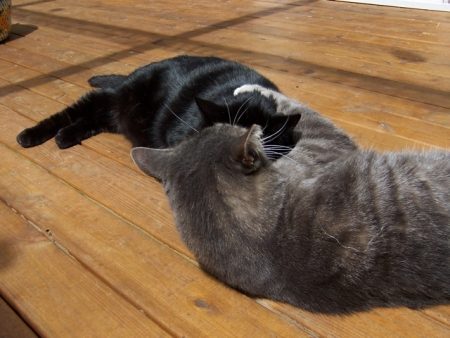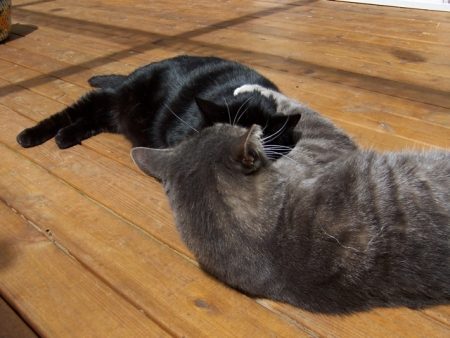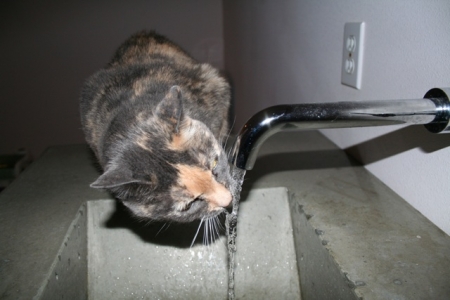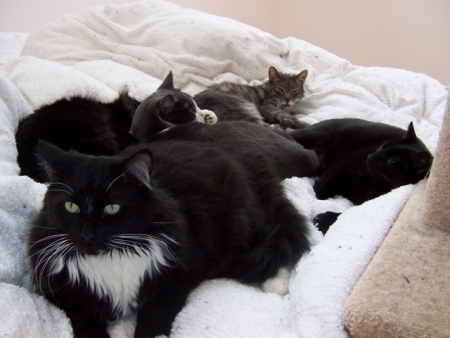

Cats love the velvet paw treatment
On Saturday I promised to tell you how to operate a harmonious cat house.
After spending some time over the weekend thinking about it, I’m wondering if I’m qualified to answer that question. I still have a lot to learn.
It’s true that I’ve rescued hundreds of cats, and fostered many of them in my home. And with a current head count of nine, I have more pets than most people.
But I’m always picking up new tricks from other animal rescuers.
Take my friend Carol Reichert at Richmond Animal Protection Society, for example. She’s the one who taught me the best way to safely introduce a new cat. Set up a large cage in your living space and let the new arrival spend some time in there each day. This gives the cats a chance to get used to each other. Nobody feels threatened. When the new cat isn’t in the cage, he should be confined separately in a room. Just letting a new cat loose in the house to fend for himself is emphatically the wrong way to make an introduction, causing rifts that can last a lifetime.
I am going through this process right now with Little Carreen, who has been living in my house for a couple of months and is still adjusting. She’s tiny, much smaller than the other cats. That sets her up to be a target for bullies. Thankfully she’s already formed bonds with two of the other cats – Sam and Henry – and they spend time visiting with her when she’s hanging out in the large master bathroom. She spends time with me in the loft when I’m writing, sitting in my lap so I can protect her.
I tried the cage idea with Madison, my 15-year-old who can’t stand other cats. Over the years I’ve tried many times to integrate her with varying success. When she stopped grooming herself and starting hiding under the bed constantly, I knew she badly needed her own space.
Madison is currently living in the daylight basement, where she enjoys snuggling up on the double bed I slept in as a child. The other day I placed her safely in the large dog-sized carrier in the middle of the living room, hoping she might start getting used to the other cats. She howled and howled in distress until I took her back to the basement.
I have resigned myself to the fact that she will probably never feel comfortable living with other animals. I visit with her several times a day, and sleep down there with her on some nights.
My cats have taught me that they occasionally need their own space to gear down and be alone with their thoughts, just like humans do.
Sam is my most social cat, both with people and other cats. But he has a contradictory side. He craves a bit of alone time each day. I found this out by accident. I started giving him a short period of solitary confinement in the basement or a bathroom when he was annoying other cats. He doesn’t hurt them, but loves to take chase. He doesn’t even have to chase to get them growling in his direction. He simply stares at them and starts rolling around on his back as a taunting maneuver.
He soon figured out a surefire way to carve out his own private time. Now he bothers the other cats on purpose. When I open the door to the bathroom, he strolls in like he owns the place. I toss a towel down and he curls up there, contented and ready for a long nap. He signals he’s ready to rejoin the group by scratching at the door.
So much for discipline.
To my surprise, Sam – previously Madison’s constant tormentor when she lived with the others – wants to spend time in the basement badly enough that he behaves when I let him in there. Madison doesn’t seem to mind having him with her in short doses.
Knowing your animals’ special likes and dislikes becomes even more important in a multiple pet household. Catering to each cat’s needs helps their mental balance. A pinch of catnip or a favorite food treat fosters contentment that goes a long way towards creating goodwill between the cats.
My calico cat Opus doesn’t like still water in a bowl, even if it’s fresh. She demands running water, and sits on the kitchen counter in front of the tap meowing until I get the message. She’s a cantankerous cat who might take a swipe at you if you reach out to pet her. But she’s very affectionate at night, when she sleeps on my head.
My feral cats will usually run if I approach them – they would rather come to me. But they are extremely vocal, and love it if I speak or sing to them. And they meow back. The cats will come and stand around me in a semi-circle if I’m having a karaoke moment. They don’t care that I can’t sing worth a hoot.
Just like people, animals have their own idiosyncrasies, and they thrive if their needs are met. Without words, they tell us how they want to be treated. We just have to watch and listen.

Opus demands running water when she’s thirsty. Maybe I should call her Queenie?

Happiness is…an afternoon nap with your best pals.
Join the newsletter and never miss out on dog content again!
"*" indicates required fields
By clicking the arrow, you agree to our web Terms of Use and Privacy & Cookie Policy. Easy unsubscribe links are provided in every email.